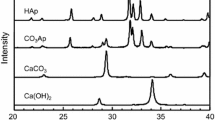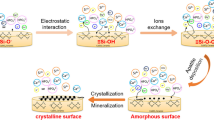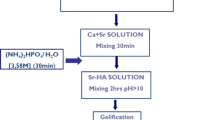Abstract
It has been proposed that one of the underlying mechanisms contributing to the bioactivity of osteoinductive or osteoconductive calcium phosphates involves the rapid dissolution and net release of calcium and phosphate ions from the matrix as alternatively a precursor to subsequent re-precipitation of a bone-like apatite at the surface and/or to facilitate ion exchange in biochemical processes. In order to confirm and evaluate ion release from sintered hydroxyapatite (HA) and to examine the effect of silicate substitution into the HA lattice on ion exchange under physiological conditions we monitored Ca2+, PO4 3− and SiO4 4− levels in Earl’s minimum essential medium (E-MEM) in the absence (serum-free medium, SFM) or presence (complete medium, C-MEM) of foetal calf serum (FCM), with both microporous HA or 2.6 wt% silicate-substituted HA (SA) sintered discs under both static and semi-dynamic (SD) conditions for up to 28 days. In SFM, variation in Ca2+ ion concentration was not observed with either disc chemistry or culture conditions. In C-MEM, Ca2+ ions were released from SA under static and SD conditions whereas with HA Ca2+ was depleted under SD conditions. PO4 3− depletion occurred in all cases, although it was greater in C-MEM, particularly under SD conditions. SiO4 4− release occurred from SA irrespective of medium or culture conditions but a sustained release only occurred in C-MEM under SD conditions. In conclusion we showed that under physiological conditions the reservoir of exchangeable ions in both HA and SA in the absence of serum proteins is limited, but that the presence of serum proteins facilitated greater ionic exchange, particularly with SA. These observations support the hypothesis that silicate substitution into the HA lattice facilitates a number of ionic interactions between the material and the surrounding physiological environment, including but not limited to silicate ion release, which may play a key role in determining the overall bioactivity and osteoconductivity of the material. However, significant net release of Ca2+ and PO4 3− was not observed, thus rapid or significant net dissolution of the material is not necessarily a prerequisite for bioactivity in these materials.




Similar content being viewed by others
References
Aoki H. Science and medical applications of hydroxyapatite. Tokyo: Takayama Press; 1991.
Maxian SH, Zawadsky JP, Dunn MG. Effect of Ca/P coating resorption and surgical fit on the bone/implant interface. J Biomed Mater Res. 1994;28:1311–9.
Moroni A, Caja VL, Egger EL, Trinchese L, Chao EYS. Histomorphometry of hydroxyapatite-coated and uncoated porous titanium bone implants. Biomaterials. 1994;15:926–30.
Ducheyne P, Radin S, King L. The effect of calcium-phosphate ceramic composition and structure on in vitro behaviour. I. Dissolution. J Biomed Mater Res. 1993;27:25–34.
Schepers E, Declercq M, Ducheyne P, Kempeneers R. Bioactive glass particulate material as a filler for bone lesions. J Oral Rehabil. 1991;18:439–52.
Dalculsi G, Legeros RZ, Nery E, Lynch K, Kerebel B. Transformation of biphasic calcium phosphate ceramics in vivo: ultrastructural and physicochemical characterization. J Biomed Mater Res. 1989;23:883–94.
Holand W, Vogel W, Naumann K, Gummel J. Interface reactions between machinable bioactive glass-ceramics and bone. J Biomed Mater Res. 1985;19:303–12.
Oonishi H, Hench LL, Wilson J, Sugihara F, Tsuji E, Kushitani S, Iwaki H. Comparative bone growth behavior in granules of bioceramic materials of various sizes. J Biomed Mater Res. 1999;44:31–43.
Weng J, Liu Q, Wolke JGC, Zhang X, de Groot K. Formation and characteristics of the apatite layer on plasma-sprayed hydroxyapatite coatings in simulated body fluids. Biomaterials. 1997;18:1027–35.
Amarh-Bouali S, Rey C, Lebugle A, Bernache D. Surface modifications of hydroxyapatite ceramics in aqueous media. Biomaterials. 1994;15:269–72.
Driessens FCM. The mineral in bone, dentin and tooth enamel. Bull Soc Chim Belg. 1980;89:663–89.
Jugdaohsingh R. Silicon and bone health. J Nutr Health Aging. 2007;11:99–110.
Gibson IR, Huang J, Best SM, Bonefield W. Enhanced in vitro cell activity and surface apatite layer formation on novel silicon-substituted hydroxyapatites. Bioceramics. 1999;12:191–4.
Hing KA, Revell PA, Smith N, Buckland T. Effect of silicon level on rate, quality and progression of bone healing within silicate-substituted porous hydroxyapatite scaffolds. Biomaterials. 2006;27:5014–26.
Patel N, Brooks RA, Clarke MT, Lee MT, Rushton N, Gibson IR, Best SM, Bonfiel W. In vivo assessment of hydroxyapatite and silicate-substituted hydroxyapatite granules using an ovine defect model. J Mater Sci Mater Med. 2005;16:429–40.
Hing K, Annaz B, Saeed S, Revell P, Buckland T. Microporosity enhances bioactivity of synthetic bone graft substitutes. J Mater Sci Mater Med. 2005;16:467–75.
Rouahi M, Gallet O, Champion E, Dentzer J, Hardouin P, Anselme K. Influence of hydroxyapatite microstructure on human bone cell response. J Biomed Mater Res A. 2006;78:222–35.
Guth K, Campion C, Buckland T, Hing KA. Surface physiochemistry affects protein adsorption to stoichiometric and silicate-substitute microporous hydroxyapatites. Adv Eng Mater. 2010;12:B113–21.
Guth K, Campion C, Buckland T, Hing KA. Effect of silicate-substitution on attachment and early development of human osteoblast-like cells seeded on microporous hydroxyapatite discs. Adv Eng Mater. 2010;12:B26–36.
Stephansson SN, Byers BA, Garcia AJ. Enhanced expression of the osteoblastic phenotype on substrates that modulate fibronectin conformation and integrin receptor binding. Biomaterials. 2002;23:2527–34.
Botelho CM, Lopes CA, Gibson IR, Best SM, Santos JD. Structural analysis of Si-substituted hydroxyapatite: zeta potential and X-ray photoelectron spectroscopy. J Mater Sci Mater Med. 2002;13:1123–7.
Balas F, Perez-Pariente J, Vallet-Regi M. In vitro bioactivity of silicon-substituted hydroxyapatites. J Biomed Mater Res A. 2003;66:364–75.
Botelho CM, Brooks RA, Spence G, McFarlane I, Lopes MA, Best SM, Santos JD, Rushton N, Bonfield W. Differentiation of mononuclear precursors into osteoclasts on the surface of Si-substituted hydroxyapatite. J Biomed Mater Res A. 2006;78:709–20.
Bohner M. Silicon-substituted calcium phosphates—a critical view. Biomaterials. 2009;30:6403–6.
Gibson IR, Best SM, Bonfield W. Chemical characterisation of silicon-substituted hydroxyapatite. J Biomed Mater Res. 1999;44:422–8.
Hing K, Wilson L, Buckland T. Comparative performance of three ceramic bone graft substitutes. Spine J. 2007;7:475–90.
Chen PS, Toribara TY, Warner H. Microdetermination of phosphorus. Anal Chem. 1956;28:1756–8.
Grundel R. Microscopical and biochemical studies of mineralised matrix production by human bone derived cells. Thesis submitted for Doctorate of Philosophy to Department of Orthopaedic Surgery and Wolfson College, University of Oxford, Oxford; 1995. p. 328.
Raggi MA, Sabbioni C, Mandrioli R, Zini Q, Varani G. Spectrophotometric determination of silicate traces in hemodialysis solutions. J Pharm Biomed Anal. 1999;20:335.
Pietak AM, Reid JW, Stott MJ, Sayer M. Silicon substitution in the calcium phosphate bioceramics. Biomaterials. 2007;28:4023–32.
Guth K, Buckland T, Hing KA. Silicon dissolution from microporous silicon substituted hydroxyapatite and its effect on osteoblast behaviour. Key Eng Mater. 2006;117:309–11.
Harding IS, Rashid N, Hing KA. Surface charge and the effect of excess calcium ions on the hydroxyapatite surface. Biomaterials. 2005;26:6818–26.
Rashid N, Harding IS, Buckland T, Hing KA. Nano-scale manipulation of silicate-substituted apatite chemistry impacts surface charge, hydrophilicity, protein adsorption and cell attachment. Int J Nano Biomater. 2008;1:299–319.
Porter AE, Botelho CM, Lopes MA, Santos JD, Best SM, Bonfield W. Ultrastructural comparison of dissolution and apatite precipitation on hydroxyapatite and silicon-substituted hydroxyapatite in vitro and in vivo. J Biomed Mater Res A. 2004;69:670–9.
Wilson CJ, Clegg RE, Leavesley DI, Pearcy MJ. Mediation of biomaterial-cell interactions by adsorbed proteins: a review. Tissue Eng. 2005;11:1–18.
Kokubo T, Kushitani H, Sakka S, Kitsugi T, Yamamuro T. Solutions able to reproduce in vivo surface-structure changes in bioactive glass-ceramic A-W. J Biomed Mater Res. 1990;24:721–34.
Jager M, Fischer J, Schultheis A, Lensing-Hohn S, Krauspe R. Extensive H(+) release by bone substitutes affects biocompatibility in vitro testing. J Biomed Mater Res. 2006;76:310–22.
Coessens BC, Miller VM, Wood MB. Endothelin-A receptors mediate vascular smooth-muscle response to moderate acidosis in the canine tibial nutrient artery. J Orthop Res. 1996;14:818–22.
Li JF, Eastman A. Apoptosis in an interleukin-2 dependent cytotoxic T-lymphocyte cell line is associated with intracellular acidification—role of the NA+/H+ antiport. J Biol Chem. 1995;270:3203–11.
Furlong IJ, Ascaso R, Rivas AL, Collins MK. Intracellular acidification induces apoptosis by stimulating ICE-like protease activity. J Cell Sci. 1997;110:653–61.
Suzuki T, Yamamoto T, Toriyama M, Nishizawa K, Yokogawa Y, Mucalo MR, Kawamoto Y, Nagata F, Kameyama T. Surface instability of calcium phosphate ceramics in tissue culture medium and the effect on adhesion and growth of anchorage-dependent animal cells. J Biomed Mater Res. 1997;34:507–17.
Hunter GK, Hauschka PV, Poole AR, Rosenberg LC, Goldberg HA. Nucleation and inhibition of hydroxyapatite formation by mineralized tissue proteins. Biochem J. 1996;317(Pt 1):59–64.
George A, Veis A. Phosphorylated proteins and control over apatite nucleation, crystal growth, and inhibition. Chem Rev. 2008;108:4670–93.
Denhardt DT, Guo X. Osteopontin: a protein with diverse functions. FASEB J. 1993;7:1475–82.
Author information
Authors and Affiliations
Corresponding author
Rights and permissions
About this article
Cite this article
Guth, K., Campion, C., Buckland, T. et al. Effects of serum protein on ionic exchange between culture medium and microporous hydroxyapatite and silicate-substituted hydroxyapatite. J Mater Sci: Mater Med 22, 2155 (2011). https://doi.org/10.1007/s10856-011-4409-1
Received:
Accepted:
Published:
DOI: https://doi.org/10.1007/s10856-011-4409-1




